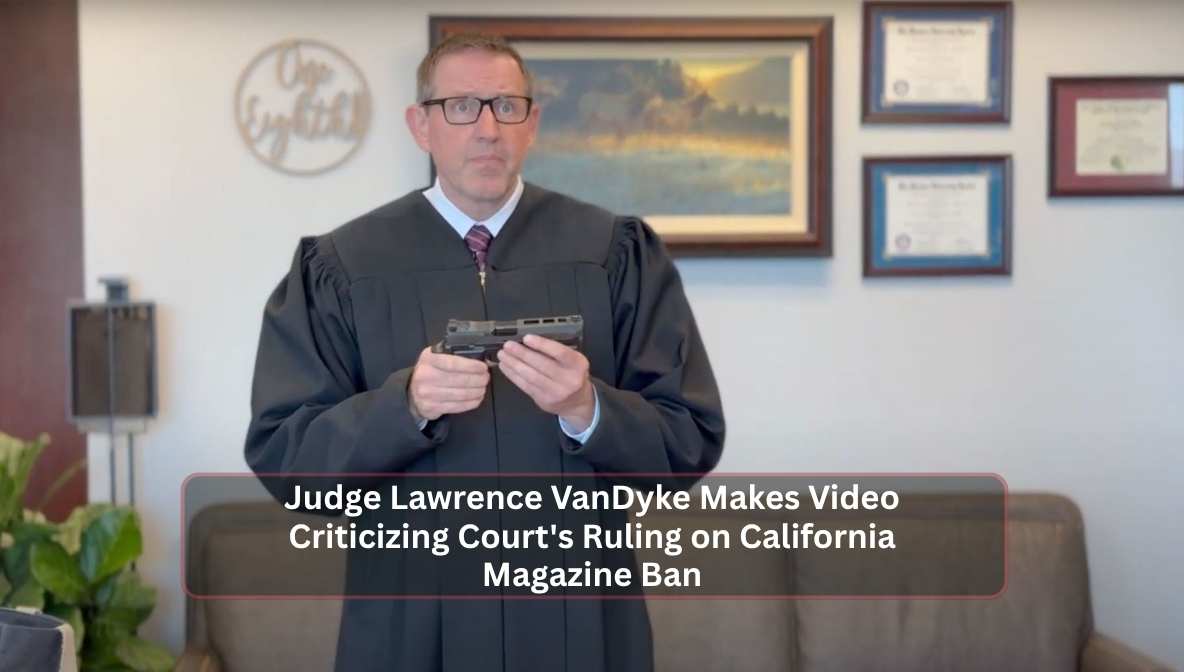An unusual step was taken by Judge Lawrence VanDyke on the U.S. Court of Appeals for the Ninth Circuit when he recorded a video to criticize the court keeping California’s large-capacity magazine ban. The incident, now widely referred to as the case where Judge Lawrence VanDyke Makes Video Criticizing Court’s Ruling on California Magazine Ban, has sparked widespread discussions on appropriate judicial behavior, the scope of gun rights, and the boundaries of dissent within the judiciary.
The issue in the case is Duncan v. ASR challenged in court the California law preventing people from using magazines with more than ten bullets. Most judges decided to ban these magazines, but Judge VanDyke stated in his video remark that such mags are important for guns and therefore deserve Second Amendment protection.
Key Points:
- Judge VanDyke’s video dissent is special for including a two-minute animation about how a guns works.
- Other judges have criticized the judge for his actions in the video.
- The case draws attention to disagreements over guns and our rights as Americans.
Why did Judge VanDyke make a video version of his dissent?
VanDyke created the video dissent because he disagreed with the decision handed down by the majority in Duncan v. Bonta revealed that he lacked a basic knowledge of firearms. He said that big magazines are not simply add-ons, but are necessary for many firearms to function as they should.
Judge VanDyke takes the video viewer through the disassembly process of various firearms to demonstrate how limiting magazine capacity reduces the firearm’s use. Roberts pointed out that paying attention to practical matters would have meant safer gun laws and fewer problems for Second Amendment defenders.
Stevens hoped to show his arguments clearly by making filmed dissents, rather than merely write them down as courts often do.
What Reaction Did the Court Have to the Video?
Colleagues on the Ninth Circuit have criticized Judge VanDyke’s decision to release his video dissent. According to Judge Marsha Berzon, the video has no place in the case and portrayed Judge VanDyke as a questionably qualified expert witness.
Certain judges worried that the video displayed too much advocacy which may untangle the difference between opinion and impartiality in the judiciary. They objected that such protests could result in judges including outside materials in their decisions which would harm the integrity of the appeals system.
Despite the criticism, Judge VanDyke said that the video was a artistic demonstration of his position and not meant to add new evidence to the case.
What Happens to the Law Because of the Supreme Court Ruling?
By deciding to allow California’s restriction, the court supports the state in using gun laws to maintain public safety. The majority of the court found that magazines do not fall under Second Amendment protection because they have always been considered restrictions on firearms.
Thanks to this ruling, future state gun control laws and future decisions about the Second Amendment may be affected. As a result, judging firearm rules becomes about aligning them with old customs and ensuring they are safe for everyone.
The dissents and Judge VanDyke’s as well, point out that there are still arguments within courts on how sweeping the Second Amendment rights should be and how they interact with rules put in place by lawmakers.
How Does This Case Relate to News and Opinion about Gun Control?
Richard Dunne brought Duncan v. The Bonta case brings up major issues about gun control, what rights people have and how to make communities safe. Those in favor of the magazine ban say it can prevent mass shootings from being so deadly and improve safety for everyone. Even so, people who argue against these laws believe they restrict rights guaranteed in the U.S. Constitution and stop people from protecting themselves legally.
VanDyke’s video dissent highlights these arguments, says the majority got it wrong and supports a wider interpretation of Second Amendment protections. It demonstrates how separating the rights of people from the protection required for public safety is still a big challenge in gun control laws.
What Kind of Dissents Have Happened in Court Through Video?
It is rare for a federal judge to use a video to express a dissent and no similar cases have been set in the federal system. Longstanding practice is for judges to record their disagreements in writing that fits with recognized legal rules. Adding multimedia to judicial decisions leads to questions about what judges should do and how this could affect legal work.
Even though the video made the judge’s viewpoint clearer, some were worried about the methods used and why judges needed to demonstrate such methods on video for the public. The debate about the video might bring about talks among legal experts on how judges should behave in the digital era.
Conclusion
His online dissent in Duncan v. Bonta brings an imaginative and nonstandard approach to judicial writing that opposes tradition and encourages many discussions. Even though what he did drew criticism from experts and other judges, it also points to disagreements about interpreting the Second Amendment and the judiciary’s place in forming public policy.
This case points to the requirement for transparent rules on judge behavior and the value of safeguarding the system as ideas are introduced.
FAQ’s
1. What do we learn from Judge VanDyke’s rejection of the decision?
The video dissent from Judge VanDyke is significant because, for the first time, a judge explained their decision using visual tools which has started a discussion on the role and manners of judges and the meaning of the Second Amendment.
2. Why did Judge VanDyke make the video?
He published this video because he believed large-capacity magazines are required in firearms, should be allowed by the Second Amendment and that the court majority didn’t properly understand the technical aspects of how firearms operate.
3. What did other judges think about the video?
Many judges said the video was “extremely inappropriate,” as it contained out-of-record facts and almost merged the roles of judge and advocate.
4. How did the court decide in Duncan v. Bonta entail?
According to the ruling, California is entitled to ban magazines with more than ten rounds, as historically, firearms and ammunition amounts could be limited by lawmakers.
5. Could what’s revealed in this case influence proposals for new gun laws in the future?
It’s possible that this case may have an effect on firearm accessory laws across the US and how judges explain relevant parts of the Second Amendment.


